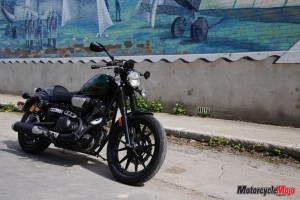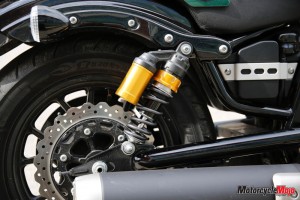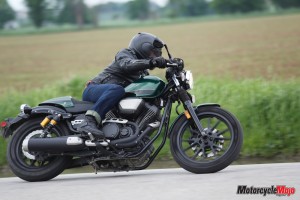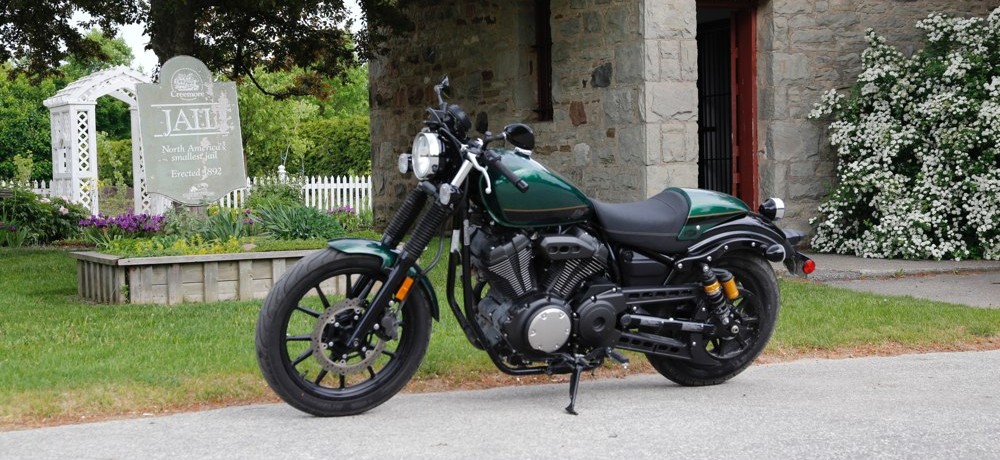Yamaha’s bestselling cruiser puts on a new disguise
Pay no attention to the man behind the curtain said the small voice in my head, but the veil had been drawn and behind all that emerald paint was . . . well, exactly what you’d expect. There’s no point tiptoeing around the blatantly obvious: this is no café racer.
I’ll skip most of the history lesson about café culture and its origins, as that story is starting to sound like “Stairway to Heaven” at a cover band convention. Perhaps that’s why Yamaha has stopped short of calling it a café and has instead dubbed this newest version of its Bolt the C-Spec. Subtle? Perhaps not.
Less Equals More
 What should be said about café motorcycles is that they resulted from a desire to go faster, and on a limited budget in most cases. The easiest and most cost-
What should be said about café motorcycles is that they resulted from a desire to go faster, and on a limited budget in most cases. The easiest and most cost-
effective way to do that was not to add power, but to remove weight; the result of such modifications was a bike devoid of extraneous parts. If it didn’t absolutely, positively need to be there, then into the bin it went.
Aside from the reduced weight and improved performance, paring down a motorcycle reveals the bones of a design, the structure that dictates not only appearance, but the way a rider will interact with the machine through the control points, the geometry that dictates its handling characteristics and, to a discerning eye, the shortcomings that will make themselves known in due time.
In the case of a café, starting with an appropriate base requires less to be taken off, and Yamaha’s Bolt has very little in the way of extras. It follows the Harley Sportster’s ethos of offering a basic design that can take on any likeness (think of a bobber, chopper, flat tracker, café and so on). This universality makes the Bolt an obvious choice for Yamaha’s styling exercises.
A set of clip-on bars and pegs, relocated slightly rearward, encompass the primary changes required to achieve motorcycling’s “look of the moment.” A solo seat cover, fork gaiters, deleted passenger pegs, actual metal fenders, black light pods with chrome bezels and blacked-out everything else shores up a solid performance in the looks category for this new variant.
Everything in Its Place
 None of the bike’s details look out of place – most certainly an accomplishment worthy of some note, and it’s thanks to the basic and, more importantly, classic structure of the Bolt. A 942 cc, air-cooled, 60-degree V-twin putting out 59.3 ft-lb of torque at just 3000 rpm nestles into a classically styled and executed single backbone, double cradle frame. The steering-head angle is 29 degrees, whereas most cruisers tend to creep out to 32 degrees, meaning the Bolt retains some liveliness in its handling characteristics while remaining relaxed. Aiding the bike’s ability to scratch – or completely obliterate – the stock foot pegs is a pair of “piggyback” shocks providing just 70 mm of firmly damped, though confidence-inspiring, travel. These suspenders add a modern hot-rod look, and aside from delivering a harsh jolt over sharp-edged bumps, settle things down quickly and are a standout feature.
None of the bike’s details look out of place – most certainly an accomplishment worthy of some note, and it’s thanks to the basic and, more importantly, classic structure of the Bolt. A 942 cc, air-cooled, 60-degree V-twin putting out 59.3 ft-lb of torque at just 3000 rpm nestles into a classically styled and executed single backbone, double cradle frame. The steering-head angle is 29 degrees, whereas most cruisers tend to creep out to 32 degrees, meaning the Bolt retains some liveliness in its handling characteristics while remaining relaxed. Aiding the bike’s ability to scratch – or completely obliterate – the stock foot pegs is a pair of “piggyback” shocks providing just 70 mm of firmly damped, though confidence-inspiring, travel. These suspenders add a modern hot-rod look, and aside from delivering a harsh jolt over sharp-edged bumps, settle things down quickly and are a standout feature.
The 41 mm front fork is noticeably softer than the rear setup, resulting in a ham-and-egg-type relationship between the fore and aft, with the latter faring better on smooth surfaces and at higher speeds, while the former does a better job of smoothing out rough surfaces and dealing with potholes or speed bumps.
Though the front end has an intentionally retro appearance thanks to those fork gaiters, headlight housing and traditional frame, the wave-style 298 mm front disc and two-piston
caliper look and work as a modern stopper should, so too the rear’s matching 298 mm disc and single-piston caliper. My first application of the front brake just about planted my face on the top triple clamp, but after bedding in the brake pads, the harsh initial bite disappeared, resulting in a lever in need of a firm grip and some rear brake to get the Bolt slowed down quickly.
Something Old, Something New
 Continuing the old-meets-new motif is the simple speedo with basic warning lights; no tachometer or information centre needed here – the big twin will let you know what part of the power band you’re in and when to shift. That’s just as well, because in certain light conditions with sunglasses on, the black numbers on the grey LCD display are all but invisible. The communication between this bike and the rider, without the need for electronics, makes the Bolt C-Spec fun and involving, and I felt immediately at home on it.
Continuing the old-meets-new motif is the simple speedo with basic warning lights; no tachometer or information centre needed here – the big twin will let you know what part of the power band you’re in and when to shift. That’s just as well, because in certain light conditions with sunglasses on, the black numbers on the grey LCD display are all but invisible. The communication between this bike and the rider, without the need for electronics, makes the Bolt C-Spec fun and involving, and I felt immediately at home on it.
From the cockpit, the view is tidy and minimalistic, even the wiring and cables are routed neatly, showing as usual that Yamaha had an eye on most of the details, with the exception being the switchgear. That, of course, is carried over from elsewhere in the company’s parts department – now standard operating procedure for most manufacturers.
Rolling around on the C-Spec reveals a rock-solid build, with no shaking bits or rattling pieces. Tolerances feel tight and there’s barely any plastic in sight, lending some credibility to the model designation, as there’s little room for plastic on a proper café, or cruiser for that matter.
Shifting the five-speed gearbox highlights a mechanical feeling with a very positive engagement of every gear and a light clutch pull with the friction point occurring about halfway through the lever’s travel, making quick launches and slow-speed manoeuvring easy.
While Away the Time
The seat sits at 763 mm, and though higher than I expected, kept me pain-free and enabled me to while away the hours over more than 1000 km and a week of commuting. The clip-on bars also remained comfortable for the duration of my testing, with only a slight reach required to grasp them. They may look like traditional café clip-ons, but in reality they have a significant riser built in and place the rider in only a slight tuck. That same position also puts a little more weight over the front wheel and encourages dipping a shoulder into corners – until the pegs begin making awful sounds and the narrow front tire starts to object.
The Troublesome Bits
There were really only a few things that bothered me about Yamaha’s new Bolt C-Spec, and topping that list is the surge from a closed throttle to open throttle while mid-corner in first or second gear, causing the bike to push wide. The sensation was made all the more unnerving when the throttle was closed again in an attempt to tighten the arc back up, resulting in strong engine braking drastically reducing what little speed remained. Only feathering the clutch tamed this carnival ride, which is most likely due to a combination of emissions-conscious factory fuel mapping and the torque-rich nature of a large V-twin.
Next on the not-so-nice list is valve train noise when coming to a stop. I wear a camera and microphone for most test rides, and when reviewing the videos, a ticking could be heard over the exhaust note and I repeatedly made reference to it on the recordings.
My last complaint is the first thing I noticed when getting on the bike: the pegs are located exactly where my feet want to go while at a stop. Not a big issue, but try sitting on a C-Spec and you’ll immediately see what I mean.
From a handling perspective, the ground clearance issue, lack of rear suspension travel and relaxed steering keep this bike firmly planted in the cruiser segment. The same can be said about the Bolt’s air-cooled V-twin; it puts out smooth power and plenty of it, but there’s no reward for exploring its limits. This motorcycle is most at home blasting from stoplight to stoplight or cruising between 70 and 110 km/h.
Kind of Like . . .
Think late-1960s small-block muscle car with some modern touches, or better yet a 1960s pony car with a decent suspension setup, and you’re in the C-Spec’s ballpark. It’s solid and lots of fun, and you’d definitely want to be seen in public with it (vanity got the better of me on a couple of occasions and I may have paraded it around a bit), but don’t expect to “do the ton” if there are more than a couple of corners to negotiate.
At $9,699, the C-Spec delivers really good value, and if I were buying a cruiser, this one might just do it for me. I could even live with the gas light coming on after 180 km, especially after I perused the best factory accessories catalogues this side of Milwaukee; if you’re interested in personalizing your bike, Yamaha has you covered like no other Japanese cruiser manufacturer. My perfect Bolt C-Spec would wear a set of factory-available spoked wheels instead of the stock cast items, a few of the brass covers from the catalogue and the same emerald green paint – they call it “Dark Grayish Metallic Green.” Seriously? Okay, so they missed on the name of the colour, but it looks much better than it sounds.
Taking into account all the pros and cons of the Bolt C-Spec brings me to the conclusion that Yamaha is not trying to fool anyone into thinking the Bolt C-spec is something it’s not. There’s no sham behind this café’d curtain, but I did find my preferred Yamaha cruiser, and think it would be right at home in my garage.





















